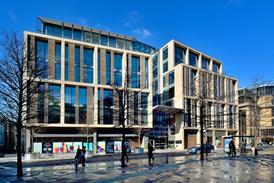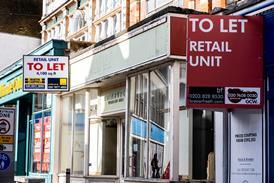Since the pandemic ushered in new work patterns, prime commercial property’s chasing pack has fallen further behind the market’s leaders. There are knock-on effects for property lawyers, reports Maria Shahid
The low down
Commercial property lawyers are dealing with a divided market. Prime city-centre offices with top environmental credentials are at a premium – attracting tenants and investors. Yet a chasing pack, including buildings that need retrofitting to compete on energy efficiency, may find they are in a long queue for approval for proposed works by the Building Safety Regulator (BSR). The BSR is proving to be a bottleneck that is holding up investment and economic growth. Also on lawyers’ minds is legislation going through parliament that might ban upward-only rent reviews. Aimed at boosting the life of English high streets, the commercial sector was blindsided by its inclusion in a bill. Property investors are taken aback. Yet the sector’s outlook for 2026 is one of cautious confidence.
Commercial property has been in flux post-pandemic. While return-to-work mandates have increased demand for office premises, a two-tier market has emerged, with buildings in core locations offering occupants on-site amenities and with higher green credentials attracting the most interest.
Recent figures published by Savills show that since 2020, rental growth rates for prime and secondary properties in central London, which once followed a similar trajectory, have diverged significantly. While prime rents have grown 11.8%, secondary rents are up just 4.8%. The same report found that leasing activity in central London was up by 18% on the same quarter in 2024, amid ‘robust levels of demand’. Demand in core locations has kept vacancy rates low.
The drive to build more energy-efficient buildings does not only reflect tenant demand. There is growing sector pressure to meet net zero targets, which is filling the gap left by legislation.
'Lower-grade office space, which is less ‘green’, and more local, is harder to shift'
Susan Ryan, Ellisons
The Minimum Energy Efficiency Standards (MEES) only require non-domestic buildings to reach a minimum energy performance rating of E, but this is expected to rise to B by 2030. While the government has consulted on this higher EPC rating for some years, there is still no real indication of when it will become law. In anticipation of this change, investors and developers are already exceeding current energy-efficiency targets, and green lease provisions are increasingly the norm in commercial leases.

‘One of our office clients is finding that demand for high-quality green offices is actually quite high, because there’s very little supply,’ says Susan Ryan, a partner in Ellisons’ commercial property team in Bury St Edmunds. ‘What we are finding is that the lower-grade office space, which is less “green”, and more local, is harder to shift, whereas in that primary market, the rents are relatively high, and they go quite quickly.’
'Some landlords are speculatively fitting out a whole building and letting it on that basis. It definitely puts them in an advantageous position'
Jason Tann, Howard Kennedy
The ‘flight to quality’ has led to different types of leasing structures being offered by landlords, says Cara Imbrailo, a partner at Charles Russell Speechlys in London: ‘There are more options on the table, and our landlord clients, who would traditionally only have operated in one way, are now having open conversations with tenants about making the space suitable for their needs. Whether that’s a 10-year lease with a break at five, shorter-term leases, “plug and play”, which spares the tenant some of the cost and time involved in fitting it out themselves, or the tenants wanting fully managed spaces.’
Clyde & Co partner Annabelle Redman predicts demand and supply issues arising: ‘While there are increasing occupational requirements for these “best-in-class properties”, less is coming on stream.’ This, she says, is due to less developer confidence in the post-Covid market: ‘Debt costs make it harder for schemes to be viable. The result is that rents are being pushed up in the City, meaning that occupiers are now looking at other buildings as well.’
Despite this, Redman is confident of a return to activity: ‘As rents go up, developers’ confidence in the market will return, and they will start building again. While this leasing activity hasn’t yet turned into an increase in trading on the investment side, I think it will – it’s only a matter of time. I have acted on a couple of office investments already this year.’
Meanwhile, landlords in the secondary market are using novel tactics to attract tenants unable to find or afford prime space. ‘Some landlords are now letting fitted space, including furnishings and fittings, to enable the tenant to move in straight away,’ says Jason Tann, a partner at Howard Kennedy. ‘They will do it at their own cost, but the quid pro quo is a higher rent, a reduced rent-free period and a reduction of other incentives. Some landlords are speculatively fitting out a whole building and letting it on that basis. It definitely puts them in an advantageous position.’
Other landlords in this secondary market are turning offices into hotels, while some are developing a flexible office offering. Others still are converting to residential use, depending on location.
Rent review reform
A proposal to ban upwards-only rent reviews was included in the English Devolution and Community Empowerment Bill in early July. Described as ‘one of the most significant changes to English commercial leasing in quite some time’, this has caught the commercial property sector off guard.
Common in commercial leases, upwards-only rent reviews have clear advantages for landlords and investors, as they prevent rent from falling in line with the market.
This of course can leave tenants potentially paying above market rent, even in an economic downturn. The government’s intention is to revive a flagging high street, help small businesses and boost local economies.
Critics of the proposal, however, argue that a provision which had little prior industry consultation has the potential to affect investor confidence in the commercial property market significantly. Melanie Leech, chief executive of the British Property Federation, noted: ‘Interference in long-established commercial leasing arrangements without any prior consultation or warning has no place in the Devolution Bill.’
‘It filtered out very much under the radar,’ says Ryan. ‘It could lead to initial rents being higher, if the landlord knows that they are not going to be able to get increases on top of that. A lot of the heads of terms we are seeing are RPI-linked increases rather than open market ones.’ As the legislation will not have a retrospective effect, currently many heads of terms still include upward-only provisions, she adds.

Tann is critical: ‘Most high street retail leases are fairly short and without rent reviews. The main impact of this is going to be outside of the high street on the investment market for commercial property. A secure income stream is one of the main attractions of the commercial property investment market, for pension funds as well as other investors. It’s probably not for the government to legislate on the commercial bargain that is negotiated between landlords and their tenants.’
Owen Spencer, a specialist lawyer in the corporate occupiers team at Forsters in London’s Mayfair, notes that the ban could also have longer-term negative consequences for occupiers: ‘Moving to a position where rent reviews could go down would be a far less attractive prospect for real estate investors. There is already a significant undersupply of Grade A office stock in central London and anything which discourages new schemes from being developed will limit supply further and potentially push up rents. This isn’t what anyone is asking for.’
Warming up: green leases
In 2020 the last government proposed introducing energy performance certificates with a rating of at least B for commercial properties, but as yet no regulations have been enacted. Commercial properties are still only required to have an EPC rating of E.
Earlier in the year, the Climate Change Committee, which advises the government and the devolved assemblies, noted in its Progress Report to Parliament that greenhouse gas emissions from non-residential buildings needed to fall by nearly 87% by 2040 in order to reach net zero by 2050. Meanwhile, in October the committee, in response to a request for advice by the government, warned that buildings and infrastructure need to be equipped to cope with global temperatures reaching 4C above pre-industrial levels by the end of the century.
While legislative pressure to meet a higher EPC rating is still lacking, industry pressure to meet net zero targets has meant that green lease provisions are growing in popularity. ‘We’ve got some vague guidelines around EPC B, but there’s no hard-and-fast deadline, and in the meantime, ESG considerations are almost filling the gap, where companies have their own responsibilities to their shareholders and investors, which is flowing through into the lease provisions,’ says Ellisons partner Susan Ryan.
‘Pre-pandemic, we only encountered green lease clauses occasionally, but five years from Covid, they are now market standard, and not particularly contested during negotiations,’ notes Charles Russell Speechlys partner Cara Imbrailo.
The Model Commercial Lease, the market’s ‘base template’, embeds a sustainability schedule and was tightened to align with the Better Buildings Partnership Toolkit earlier this year. The schedule is intended to reflect market practice rather than being ahead of it. The schedule includes so-called ‘light green’ clauses such as data sharing and cooperation between the parties, which are less onerous for tenants.
‘As well as data-sharing obligations, which are pretty much in all leases now, we are also seeing restrictions being placed on tenants carrying out alterations that could damage or worsen the environmental performance of the building,’ notes Imbrailo. ‘We are also increasingly seeing obligations on tenants to use energy from renewable sources, where possible and where it’s cost-effective.’
Adoption of green lease provisions is very landlord-dependent currently, notes Wendy Martin, legal director at Ellisons, although she senses growing demand from tenants too: ‘Some of them have ESG responsibilities to their shareholders and investors, while others are more value- and price-driven. We are [also] starting to see it coming from tenants, who are making choices about a building based on its green credentials.’
Building Safety Regulator
Elsewhere, delays with the Building Safety Regulator (BSR), introduced as part of the post-Grenfell Building Safety Act 2022, continue to be a source of frustration for developers and their lawyers. Along with hold-ups in the planning system, the BSR’s approval process is cited as one of the main reasons why the development pipeline remains slow.
‘We have developers sitting on schemes that they cannot do anything with for nine or 10 months, and they are paying out debt costs on those, which means that they are reluctant to take on more into their pipeline while those schemes are stuck,’ says Redman.
The BSR oversees building safety for higher-risk buildings (HRBs), which includes both new builds and existing buildings that are being refurbished. The regulator runs a three-stage ‘gateway’ process, with gateway 2 requiring sufficiently detailed design, evidence of competence and control (the ‘golden thread’) and formal BSR approval before work can begin on site.
Management data to 31 March 2025, published in July by the BSR, showed that only 31% of gateway 2 applications for all HRBs were approved, 69% were invalid, withdrawn or rejected, and the median determination period was over 25 weeks. The figures are worse still for new builds, with only 23% of applications approved and 77% invalid, withdrawn or rejected.

Despite the government introducing a new fast-track route for new-build HRBs, along with a leadership change and extra funding to recruit more staff, lawyers note that problems remain with the gateway process, and gateway 2 in particular.
‘It is a major barrier to development, especially in London,’ says Imbrailo. ‘The new chair, Andy Roe, is making positive noises to take steps to help, but it’s not making any material impact as yet. The gateway process remains a major challenge for new HRBs under development.’
She adds: ‘The number of applications that are being rejected is quite startling as well. My practice is predominantly landlord-side and prime central London, but where they have HRBs, where tenants are needing works to their commercial units which require BSR consent, gateway 2 applications are causing a real issue in terms of timing. These are units that were not necessarily within the intended remit [of the legislation] but have been caught up in the bureaucracy.’
Tann notes that the impact of the BSA is significant on the investment market: ‘In a mixed-use building where the commercial element is sold to an investor and the building falls within the remit of the BSA, the investor could face management and liability issues that come with any building which falls under the act, as well as the restrictions on potentially carrying out works of refurbishment or redevelopment to the commercial part of the building,’ he explains. ‘A lot of commercial investors are not geared up to deal with these sorts of issues, which could mean that mixed-use buildings as an investment will lose their appeal eventually.’
Commercial landlords need to be ‘on the ball’ when it comes to understanding the ins and outs of the regime, and how to navigate it, adds Iain Benson, legal director at London, Kent and Sussex firm Cripps. ‘The issue that’s coming down the line is that the commercial sphere has not really fully understood or absorbed some of the obligations coming out of the act itself, and the statutory instruments derived from it. Developers of residential developments will have big teams to prepare the information necessary for the approvals under the gateways. However, property asset managers and investors of mixed-use HRBs, who may have made commitments to fit out to an incoming tenant, then realise during the management of their asset, whether that’s a refurbishment or a fit out, that they will have to get gateway approvals.’
A return to confidence
'There seems to be more coming through in terms of landlord and tenant work, which is great, because it’s my bread and butter'
Annabelle Redman, Clyde & Co
Lawyers remain confident of an uptick in activity in the sector into 2026. ‘While investment transactions are slow, letting activity is pretty buoyant,’ says Tann. ‘There is definitely a bit of a hiatus in the market, as we await the outcome of the budget next month, but the mood is getting more positive as we go into next year, aided by lower interest rates.’
Redman agrees: ‘There seems to be more coming through in terms of landlord and tenant work, which is great, because it’s my bread and butter.’
Maria Shahid is a freelance journalist
































No comments yet